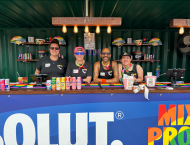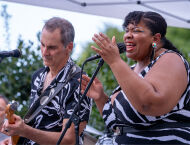Life
 Martin Luther Jr.'s "I Have a Dream Speech." Photo courtesy of National Park Service, National Archives.
Martin Luther Jr.'s "I Have a Dream Speech." Photo courtesy of National Park Service, National Archives.
Original Pages of “I Have a Dream” Speech Reinstalled at the Smithsonian
February 22, 2022 @ 2:00pm
The original pages of Martin Luther King Jr.’s “I Have a Dream” speech are on display through February 27 in the Smithsonian National Museum of African American History and Culture, about a mile from where the words were actually spoken on the steps of the Lincoln Memorial.
Originally owned by George Raveling, a basketball player and coach who volunteered at the March on Washington, the speech is part of the larger “Defending Freedom, Defining Freedom” exhibit which showcases the era of segregation from 1876 to 1968. In August of last year, Raveling donated the pages to his alma mater Villanova University; in turn, the university donated the speech to the Smithsonian museum as part of a long-term loan agreement ahead of the Martin King Luther Jr. holiday.
Also on display is the posthumous Congressional Gold Medal and the steel tub King bathed his feet in after the five-day march from Selma to Montgomery. The three pages can be found on the second concourse level in a small nook near the end of the gallery on the Modern Civil Rights Movement.
Martin Luther King Jr., like many world leaders, has transformed in people’s collective memory across the years since his death into a symbol of the qualities he stood for and the struggle for civil rights. We need exhibits and artifacts like the yellowed, typewritten pages of the speech, steel tub and Gold Medal to remember him also as a man.
We all easily envision King on a scratchy black-and-white film reciting in his preacher’s cadence the iconic refrain of “I have a dream today!” but it is difficult to imagine him pacing around the lobby of the Willard hotel the night before, anxious, not knowing what to say. The museum mementos make him more real.
The exhibit itself is quietly and tastefully showcased. Soft lights flick on around the display case upon approach. The pages are at hip level so children can read. There’s a brown-red splotch on the top-left corner of each sheet, suggesting a rusty staple. Because King improvised much of the second half of the speech, the “I have a dream” anaphora isn’t present on paper. In fact, outside of underlining the “Nows” in the “Now is the time…” repetition and two sentences underlined and asterisked (neither appear in the spoken speech),* there’s little in the way of cadence marks or notes in the margins to suggest King’s thought process on how he’d deliver his speech. However, this shows the years spent preaching in Dexter Avenue and Ebenezer Baptist Church formed him into a natural orator — and words flowed out in just the right way.
Given King’s monumental status as the leader of the Civil Rights Movement, the curators might’ve been tempted to house the exhibit in a separate room from the gallery. We can imagine this room slightly quieter, the temperature slightly cooler, the lighting slightly darker than the rest of the museum. Instead, the curators decided to place the speech papers in a small humble spot next to the panels on the Loving trial, James Meredith and a montage video of speeches from many different Civil Rights leaders. This indicates the museum’s desire to frame King not as a separate individual or event, but as one figure among many in the historic and ongoing struggle for equality.
Ultimately, the Martin Luther King Jr. exhibit — and the rest of the Smithsonian African American Museum — is a place for reflection. You kneel down and read the speech, you look at the steel tub and the posthumous Congressional Gold Medal also on display, you go home, you read about Clarence B. Jones and Stanley Levison sweating out early drafts in the Bronx, you watch the film of King delivering the speech to 250,000 people almost sixty years ago.
The silent question asked by those three pieces of paper is: What would he think about how we live today? What would he think about George Floyd and the I Can’t Breathe protests two summers ago? What would he think about Eric Garner or Trayvon Martin or Breonna Taylor? What would he think about gentrification or gerrymandering or the wealth gap or the broken education system or the war on drugs or the incarceration rates of young black males? What would he think about the American Dream now?
It can’t be said that his dream hasn’t come to pass, at least partly — the world now is not what it was in the 1960s, race relations have improved across the majority of America — but there’s so many unresolved and new issues, and so much anger and resentment swirling in the atmosphere that no one can listen to King’s dream without a touch of bitter sadness.
The pages of “I Have a Dream” is a great exhibit. It’s great because all the emotion, all the passion, hope, frustration and courage of those times lies between the margins. And it’s those emotions that were King’s true cadence marks. It’s a deeply moving experience and not to be missed.
The Smithsonian National Museum of African American History and Culture “I Have a Dream” speech exhibit will continue until February 27. To learn more about the “Defending Freedom, Defining Freedom” gallery where the exhibit is held click here. Reserve time passes to the museum here.
Smithsonian National Museum of African American History & Culture (NMAAHC): 1400 Constitution Ave. NW; nmaahc.si.edu // @nmaahc
Enjoy this piece? Consider becoming a member for access to our premium digital content. Support local journalism and start your membership today.







